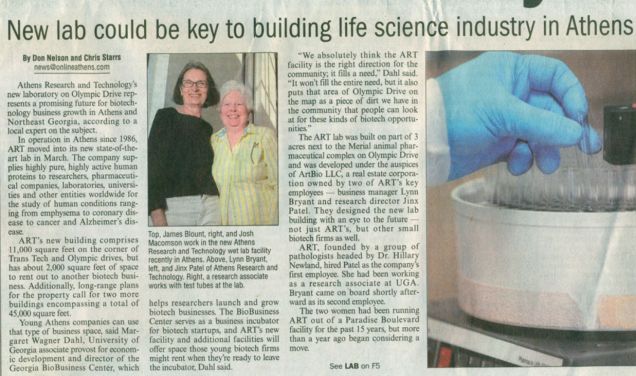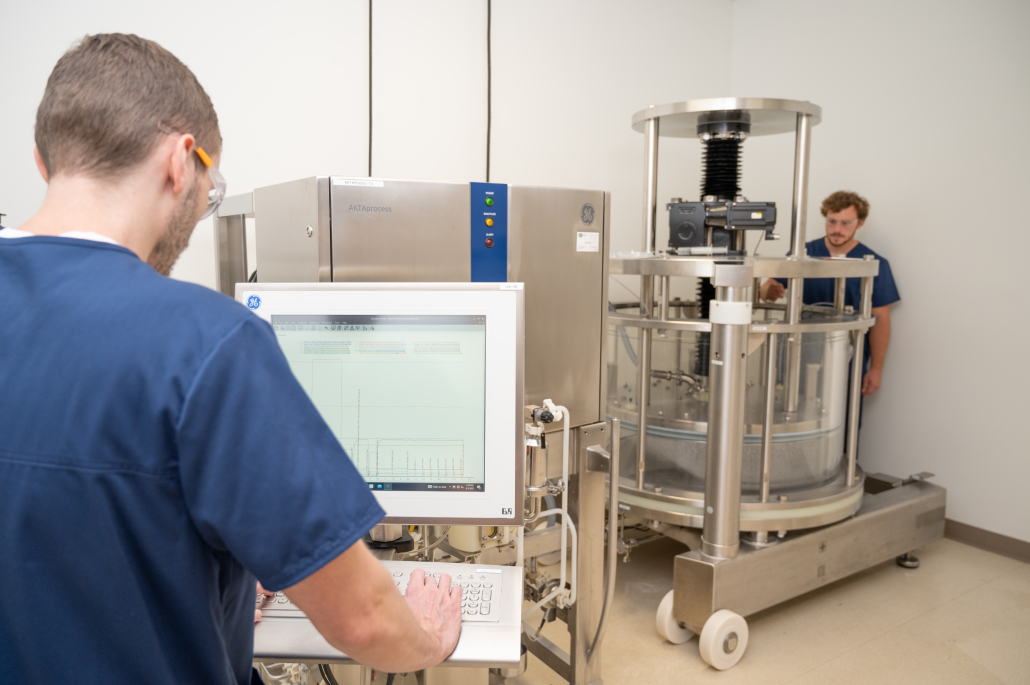Seasoned biotech with a start-up soul
![]() 5 min read
5 min read
A conversation with Athens Research & Technology’s Senior Protein Chemist Chris Landers on the company’s local connections, expansion, and investment in the future.
The year of 1986
That’s the year when IBM created the first laptop computer, Pixar was just founded, and Comet Halley reached the closest point to the Earth. It was also marked by the tragedies of Chernobyl and the Challenger Space Shuttle.
The technique of Polymerase Chain Reaction (PCR) was just published the year before. One can perhaps count the number of prominent biotech companies by hand.
That’s also the year when Athens Research & Technology (ART) was founded. A spin-off company born out of the University of Georgia more than 35 years ago, the company has been isolating and purifying proteins for research and diagnostic purposes since then.
“Senior citizen” with a young soul
You might expect that a company with more than three decades of history getting stale. But a quick look at the company’s description on their opportunities page tells another story.
“Working for Athens Research & Technology, Inc., you will have a chance to work with a privately-held, stable, solid, almost forty-year-old ‘senior citizen’ of the life science industry which has an excellent reputation for preparing quality products and providing outstanding customer support. Equally important, you will have a chance to work with a company that behaves as a young company — constantly expanding its market, developing new products, and creating innovative research partnerships.”
With its root in academia, just minutes away from the University of Georgia campus, ART forges a strong connection with its local community. It regularly recruits students and new graduates to join the company. It’s also a strong contributor to the local economy. Just recently, it was recognized as Exporter of the Year by the State of Georgia.
“This has been quite the honor for our company,” said Chris Landers, ART’s Senior Protein Chemist. “Everything we make, we make it here,” he added.
The growth of the company is hard to miss. “12 years ago, we moved into a new facility, and now we’re about to embark on a second building, another larger facility,” mentioned Chris excitedly. “We’re busting at the seams here.”
News clippings from 12 years ago when ART was about to move into the new facility.
The current ART building. Soon, ART will expand into a second, larger facility.
Tipping the scale
In addition to the production of commonly-used proteins for research and diagnostics, ART also does custom protein extraction from human and animal sources. Chris’ role is now largely in product development. If the company receives inquiries for proteins that they currently do not purify, ART scientists will evaluate if there is a market for it and determine a way for them to purify the protein at scale. “We are constantly looking to refine protocols to shorten the amount of time it takes to purify proteins and to increase the yield we get,” he said. “I never know what my day is going to be like – there is never a dull moment in my day.”
Protein extraction is typically done by chromatography – running a mixture through a stationary phase (usually in a column) that will allow the separation of components in the mixture by physical or chemical properties. ART uses a variety of chromatography methods, with columns large and small. “What’s been exciting to me is how we are moving into a scale that I never thought we would be working at, like this 120-liter column (he pointed to the column while giving a virtual tour of the lab) – it can be intimidating for sure,” Chris said.
The 120-liter column in ART’s research facility.
Some products they purify come in kilogram quantities, while others, “we would be lucky to get a couple of milligrams as a final batch.” Regardless of the quantities, the quality of what ART produces is closely monitored. The extracts are constantly assayed as part of ART’s quality control.
Investing in the future
Column size is not the only thing that matters in chromatography. When we ask Chris what the future will look like, he said, “there are always new technologies coming out as far as the bead technologies – the resins that you would have in the columns – goes. It’s always evolving. It depends on what’s hot at the time, what research is hot at the time, as far as what direction we’re heading.”
ART is also exploring the possibility of generating their protein product through recombinant technology – this could, in the future, help ART reduce the needs for source materials that are hard to find.
And with the expansion into the new facility, the recruitment of the next generation of scientists, and the exploration of new techniques, ART is also investing in an electronic lab notebook (ELN) to digitalize their processes.
“We have been keeping paper notebooks for the entirety of existence, basically. And we’ve got a conference room that we probably have several 100 notebooks in bookcases. And we realized it just wasn’t feasible.”
Chris gave an example of how the maintenance of physical paper notebooks had become a risk. “We had an overhead sprinkler go off one time, and the water in the sprinkler had some sort of oil in it. So, the water just ruined five or six notebooks – and that’s when we started thinking that we had to find a better way to do this.”
Since the implementation of SciNote ELN, ART has been able to streamline a lot of their processes. Chris highlighted its ease of use, the flexibility, and most importantly the customer support they receive. “The support from the customer success team makes a world of difference.”
Having a history doesn’t mean you stop innovating. ART is a great example of a company that maintains its strong connection with the local community and its history, and continues to move forward into the future.

If you like this post you can find similar use cases here:
- How to successfully transition to an Electronic Lab Notebook – Case study by NEUWAY Pharma
- How to successfully integrate an ELN to the lab’s processes – Case study by Ingenza
- Return on Investment When Implementing an Electronic Lab Notebook
- Routine analytics on batches of samples
- You can also read all our testimonials from academia and industry, showing the time-saving and efficiency advantages of using an ELN.
Looking for a partner in your digitalization journey?
Talk to our team & get the top-rated customer service in the ELN industry.







